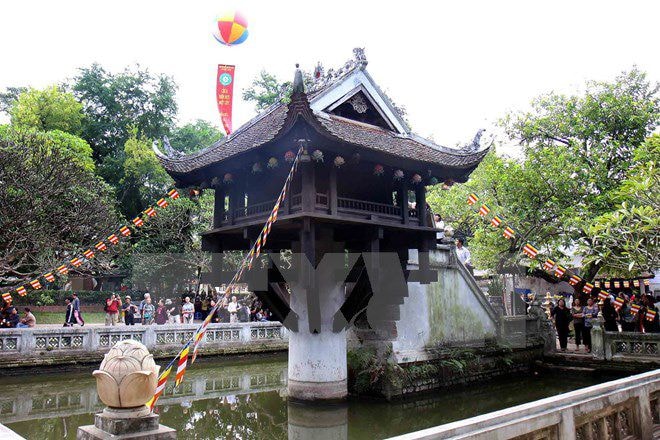Displaying precious artifacts with the theme "Lotus on antiques"
"Lotus on Antiquities" is a thematic exhibition organized by the National Museum of History, which will open on May 14.
 |
| One Pillar Pagoda |
This exhibition introduces to the public about 100 typical artifacts dating from the 7th - 9th centuries to the Nguyen Dynasty (1802 - 1945), which are part of the treasure trove of precious antiquities currently preserved at the National Museum of History. The displayed artifacts contribute to sketching the development history of plastic and decorative arts associated with the lotus symbol in the flow of Vietnamese culture; introducing to the domestic and international public the quintessential beauty and meaning of the lotus symbol in the consciousness of the Vietnamese people.
"Lotus on antiques" introduces a number of typical groups of artifacts divided into specific contents. In the content "Lotus on antiques of the Nguyen Dynasty's royal court" introduces to the public royal utensils crafted from rare materials such as jade, gold, silver, ivory... Under the skillful hands of the craftsmen, the lotus image is delicately and softly carved, making royal utensils become luxurious and precious, from worshiping objects, office objects to daily necessities...
In the content "Lotus in Buddhist art, ritual objects and worship objects", the National History Museum introduces a collection of Buddha statues, ritual objects and worship objects made of wood, bronze, ceramic, terracotta, porcelain... dating from the 11th to the 20th century. Next is the content "Lotus on architectural materials" with artifacts showing Buddhist architecture of the Ly - Tran dynasties. During this period, lotus flowers were very popular decorations, being the main motif. Lotus can be decorated in each part of the building such as on stone reliefs supporting columns, Buddha statue pedestals, floor tiles, tile borders..., but can also be a symbol of the entire building such as the One Pillar Pagoda (Ly dynasty).
Not only in Buddhism, in the royal court, lotus also exists in a rich and diverse way in daily life through the collection of daily utensils. During the Ly Dynasty, ancient artisans often engraved layers of lotus petals on ceramic bones both inside and outside of bowls and plates, then covered them with enamel and fired them. Containers such as vases, teapots, lamp stands, jars, urns, and jars were decorated with many layers of lotus petals on the lid, neck, and foot, creating a graceful, elegant, and noble beauty for each item. During the Tran Dynasty, the image of the lotus flower was expressed more vividly, freely, gracefully, and realistically.
In the Le and Nguyen dynasties, the lotus image was tightly composed but still flexible with sharp shapes creating elegance and conciseness in each work of art. In embroidery, lotus also inspired ancient artisans to create many decorative products such as embroidery and large characters with themes such as: Lotus - stork; lotus - treasure...
In Vietnamese culture, the lotus is a flower that symbolizes purity and elegance. The lotus grows from the mud and radiates its fragrance. In Buddhism, the lotus symbolizes moral values, purity, holiness, wisdom, enlightenment and an untainted spirit. In folk consciousness, the lotus is compared to people with noble beauty and bravery. Therefore, the lotus has long been part of the life and art of the Vietnamese people. The lotus is used quite commonly in the visual arts, stylized in architectural decoration and household items, worship items, and royal objects.
According to Dulich.vn






